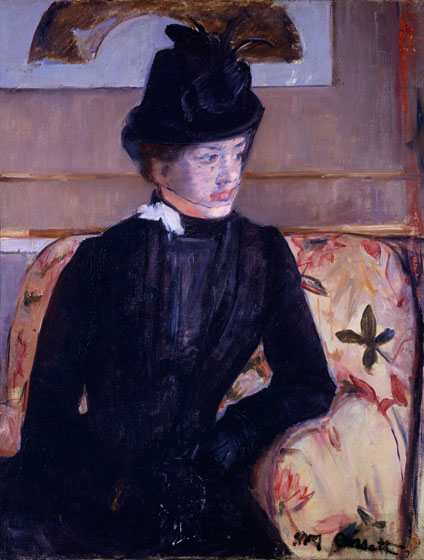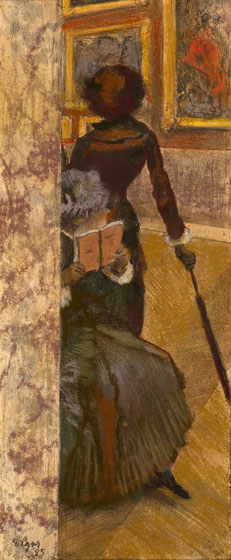Degas/Cassatt

Mary Cassatt,

Edgar Degas, Portrait after a Costume Ball (Portrait of Mme Dietz-Monnin), 1879, distemper with metallic paint and pastel on canvas, The Art Institute of Chicago, Joseph Winterbotham Collection. Photography © The Art Institute of Chicago

Mary Cassatt, At the Theater, 1878/1879, pastel and gouache with metallic paint, Collection of Ann and Gordon Getty

Edgar Degas, Fan Mount: Ballet Girls, 1879, watercolor, silver, and gold on silk, Lent by The Metropolitan Museum of Art, H.O. Havemeyer Collection, Bequest of Mrs. H.O. Havemeyer. Image © The Metropolitan Museum of Art

Mary Cassatt, Young Woman in Black (Portrait of Madame J), 1883, oil on canvas, Collection of the Maryland State Archives

Edgar Degas,

Mary Cassatt,

Mary Cassatt,

Mary Cassatt, Two Young Ladies Seated in a Loge, Facing Right, 1879–1880, softground etching and aquatint, Marc Rosen Fine Art, New York, and Adelson Galleries, New York

Edgar Degas, Mary Cassatt at the Louvre, c. 1879, pastel, Philadelphia Museum of Art, The Henry P. McIlhenny Collection in memory of Frances P. McIlhenny, 1986. The Philadelphia Museum of Art / Art Resource, NY

Edgar Degas, Mary Cassatt at the Louvre: The Etruscan Gallery, 1879–1880, softground etching, drypoint, aquatint, and etching retouched with red chalk, The Art Institute of Chicago, Albert Roullier Memorial Collection. Photography © The Art Institute of Chicago

Edgar Degas, Mary Cassatt at the Louvre: The Paintings Gallery, 1885, pastel over softground etching, drypoint, aquatint, and etching, The Art Institute of Chicago, Bequest of Kate L. Brewster. Photography © The Art Institute of Chicago

Edgar Degas, Mary Cassatt, c. 1879–1884, oil on canvas, National Portrait Gallery, Smithsonian Institution, Washington, Gift of the Morris and Gwendolyn Cafritz Foundation and the Regents' Major Acquisitions Fund, Smithsonian Institution. National Portrait Gallery, Smithsonian Institution / Art Resource, NY

Mary Cassatt, The Visitor, c. 1881, softground etching, drypoint, aquatint, etching, and fabric texture, Sterling and Francine Clark Art Institute, Williamstown, Massachusetts. Image © Sterling and Francine Clark Art Institute, Williamstown, Massachusetts, USA. Photographer Michael Agee

Mary Cassatt,

Edgar Degas,

Mary Cassatt, Child Picking a Fruit, 1893, oil on canvas, Virginia Museum of Fine Arts, Richmond, Gift of Ivor and Anne Massey. © Virginia Museum of Fine Arts. Photographer Travis Fullerton